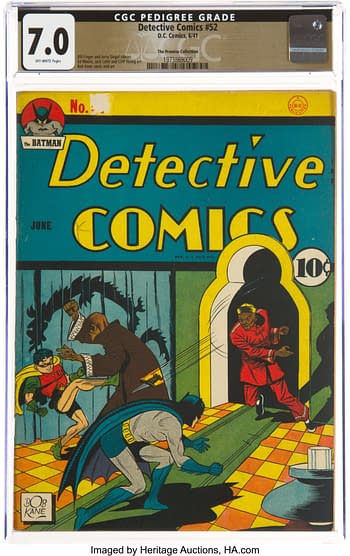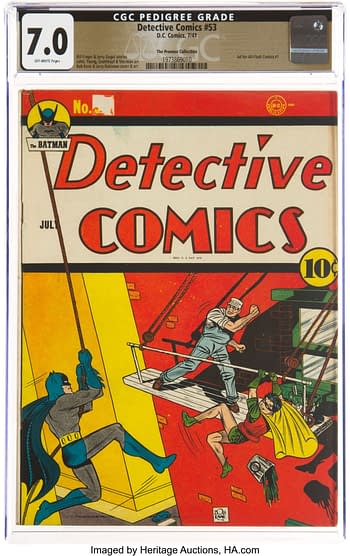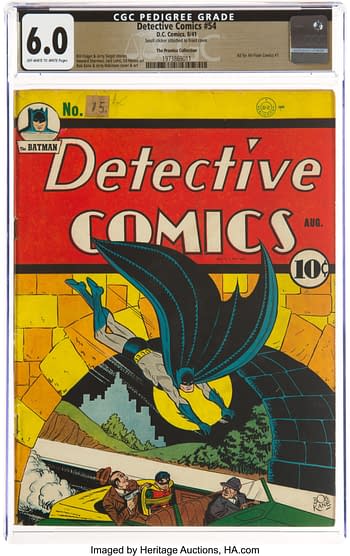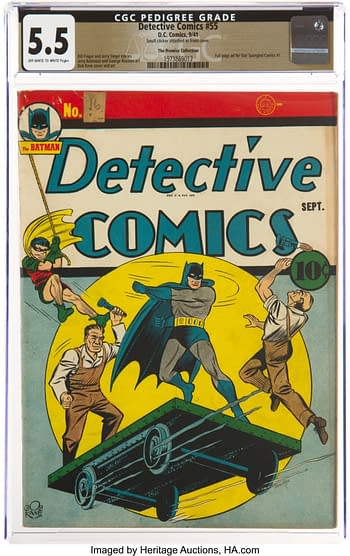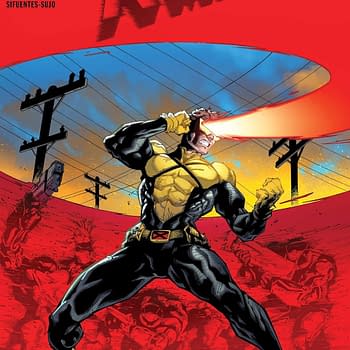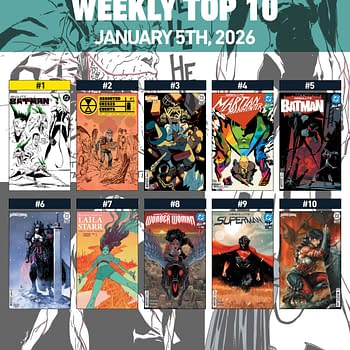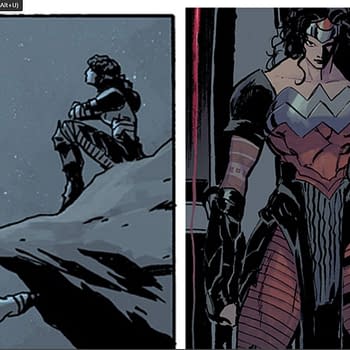Posted in: Comics, Vintage Paper | Tagged: Batman, daredevil, Promise Collection, superman
The Promise Collection 1941: Daredevils and Detectives
The publishing industry of mid-1941 was a whirlwind moment for the business of comics books. Anthologies like Action Comics, Detective Comics, Whiz Comics, and many others were going strong. Characters from Batman to Bulletman had recently received their own character-focused titles, to be joined soon by the likes of the Flash and Lev Gleason's Daredevil. The article "Up, Up and Awa-a-ay!, The Rise of Superman, Inc." in the June 21, 1941 issue of The Saturday Evening Post captures this moment in the history of American comic books better than any other contemporary account. "No other cartoon character ever has been such an all-around success at the age of three… Three times a week, millions of young spines tingle as Superman thunders hollowly over the airwaves, 'Up, up and awa-a-a-y!' then soars into space to wreck an enemy Zeppelin in full flight or extinguish a forest fire by huffing at it, as the crisis may demand. His noble profile confronts them in two magazines and 230 newspapers with a combined circulation of nearly 25,000,000. That boy is growing rare who has no Superman dungarees in his wardrobe or no Superman Krypto-Raygun in his play chest."
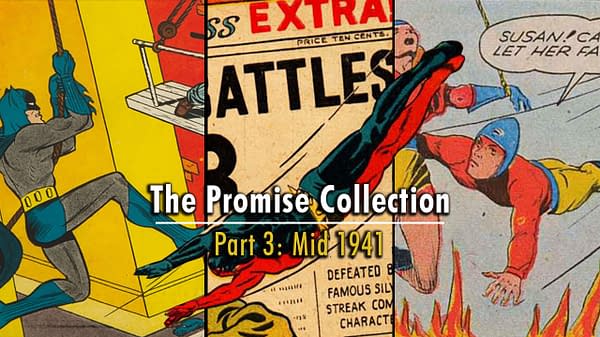
But the young boy who assembled the Promise Collection, who would have been around 10 years old in 1941, may have been one of those rare exceptions — at least in these early days. While there would be plenty of Action Comics and Superman in the years ahead, by 1941 Superman's only appearances in the collection had come via New York World's Fair 1940, World's Best Comics, and World's Finest Comics. It would seem that this young comic fan was more of a Batman and Captain Marvel fan during the early years of his collection, but it appears that he was more than willing to try new things. And 1941 was an excellent year of comic books during which to do that.
Welcome to Part 3 of the Promise Collection series, which is meant to serve as liner notes of sorts for the comic books in the collection. The Promise Collection is a set of nearly 5,000 comic books, 95% of which are blisteringly high grade, that were published from 1939 to 1952 and purchased by one young comic book fan. The name of the Promise Collection was inspired by the reason that it was saved and kept in such amazing condition since that time. An avid comic book fan named Junie and his older brother Robert went to war in Korea. Robert Promised Junie that he would take care of his brother's beloved comic book collection should anything happen to him. Junie was killed during the Korean War, and Robert kept his promise. There are more details about that background in a previous post regarding this incredible collection of comic books. And over the course of a few dozen articles in this new series of posts, we will also be revealing the complete listing of the collection. You can always catch up with posts about this collection at this link, which will become a hub of sorts regarding these comic books over time.
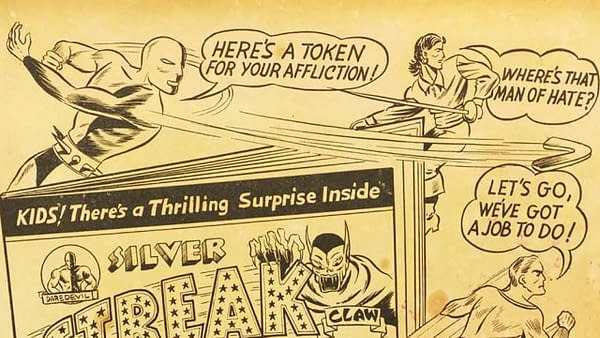
Day of the Daredevils
We typically think of this particular period of comic book history as being largely dominated by Superman, and that 1941 Saturday Evening Post article certainly bears that out, with its mention of Superman's popularity across a war-torn world, drawing the ire of Das Schwarze Korps, and a quarter million-strong Supermen of America Club whose membership included stars of the day like Mickey Rooney and Spanky McFarland. But as that piece also notes, Batman was hardly a slouch by comparison. The article claims that the Superman title itself had sales of 1,300,000 per issue at this time, "while Action Comics, featuring only one Superman story, soared to 900,000. Today Superman leads all other comic-magazine characters, one of the few within even hailing distance being The Bat Man — 800,000." No doubt Captain Marvel was another "one of the few within even hailing distance" by 1941, but we'll dive into some of those details here in the near future. Meanwhile, although Batman v. Superman has been a fandom debate for decades, there are some particular reasons that a 10-year-old comic book fan might have preferred Batman in 1941.
For most of the public, Bruce Wayne was not the only name associated with a man called Batman in the late 1930s and early 1940s, and likely not even the most famous name up to this point. Real-life figures who called themselves "Batman" or "Bat-Man", like Clem Sohn, Jimmy Caraway, and Walter Thatcher among others made frequent newspapers headlines for their exploits during this period. Most of them rather famously even wore costumes with cape-like bat wings that look a little familiar to us today. One of them even wore a costume with pointed ears and a mask, and was said to be a pretty good fighter. It's not too hard to imagine that these Batmen — professional daredevils (and at least one professional wrestler) who made the news and performed heavily around the world during this period — had an influence on the DC Comics character itself, let alone on the comic book fans who may have heard of them or even seen them in action during this period.
Of course, Batman was certainly not the only now-familiar comic book character who was influenced by daredevils. The Lev Gleason character The Daredevil, who debuted in Silver Streak Comics #6 cover-dated September 1940, had an origin that will sound very familiar to Batman fans: "Orphaned by thugs who ruthlessly killed his parents and left him speechless by the torture they inflicted on him, Bart Hill grew into manhood possessed with the determination to destroy the forces of crime and evil," with Bart shown at his parents' graves thinking to himself, "I swear to devote my time on Earth to make crime pay for the death of my mother and father." Notably, this Golden Age Daredevil's original tagline, "Master of Courage", even seems to pre-figure the Silver Age Marvel Daredevil's "Man Without Fear" catchphrase.
By 1941, Lev Gleason had given this Daredevil his own title, and Daredevil Comics #1, better known as Daredevil Battles Hitler and cover-dated July 1941, is one of the major keys present in the Promise Collection of that year. Daredevil Comics #1, with its large visage of Adolf Hitler under attack by Gleason's heroes on the cover and its even larger "Daredevil Battles Hitler" title, is one of the most famous examples of a war-era comic book cover of the period. It's also likely a little more complex under the hood than it may appear from our vantage point 80 years later. At this time, Lev Gleason was significantly involved in the politics of the era, and published and edited what were then called Communist Front magazines — the best example of these was a title called Friday. Gleason's political activities soon brought him to the attention of the FBI. In 1943, FBI chief J. Edgar Hoover wrote to the Special Agent in Charge of the New York field office, saying in part:
Information in the possession of the Bureau indicates that Gleason formerly served as the Circulation Manager of "Friday" in 1940 and that he was listed as the Editor and Publisher of "Inside of Russia", the sale of which latter publication was sponsored by the Workers Book Store in New York City. Your attention is also called to the fact that your office recently learned that the Westchester County Sheriff's Office had been contacted by the Dies Committee [popularly known as the House Committee on Un-American Activities] for information concerning numerous Communists among which was Leverett S. Gleason. The Dies Committee's interest in Gleason is not known to the Bureau.
Your office should immediately open a case on Gleason and conduct a thorough investigation to develop fully all information concerning his Communist activities and connections and any possible connections he might have with the international organization of the Party.
A deeper examination of this complex matter is outside the scope of this series, and anyone interested in learning more can take a look at the recent book, American Daredevil: Comics, Communism, and the Battles of Lev Gleason. That said, some deep background on Gleason's family history reveals he was certainly not the first member of his family whose profession saw him caught up in the machinery of politics and war in various ways. Gleason, whose full name is Leverett Stone Gleason, was named after his grandfather on his mother's side, Leverett Stone. Leverett Stone's firm "L & M Stone" is described in one Civil War-era history as "a leading forage contractor in Cincinnati." The firm provided corn, oats, and other grain to the federal government during the war, as can be seen in the Report of the Secretary of War, Contracts Made by the Quartermaster's Department, 1863-1865. And even more interestingly, his great-grandfather Thomas F. Eckert was a noted steamboat mechanic and engineer whose stint in politics saw him become an advocate of the 10-hour workday, an 1820s-1840s movement that led to organized labor efforts.
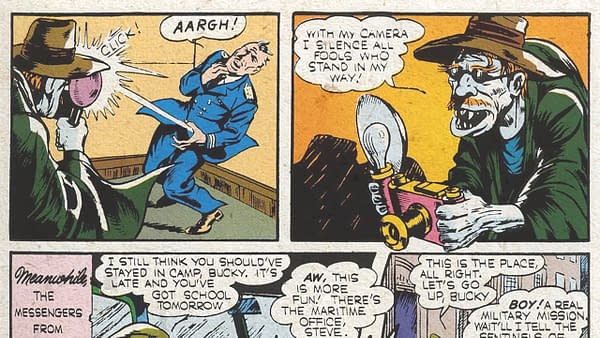
Fiends, Great and Small
The events and circumstances behind the scenes of some of the war-era comic book releases discussed here from the Promise Collection can seem a little heavy from our decades-later vantage point, but the historic weight of the moment certainly did not escape the notice of the people who observed it unfolding in 1941. Not too distant from the glowing description of the Rise of Superman, Inc, the editor of the Saturday Evening Post weighed in on the comics of 1941 in less glowing terms, "It is a sinister thing that the comics should be turned to war propaganda… but this propaganda is all-pervasive anyway and a child who never saw a comic strip would still not escape it. The radio, motion pictures, the news columns, Boy Scout troops, even the games boys play, will reflect this drive toward war increasingly."
While the era certainly was heavy with war-influenced content even ahead of America's entry into WWII in December 1941, the war-themed content of the 1941 comic books in the Promise Collection was certainly not all-encompassing. In the pages of both Batman and Detective Comics, Batman and Robin settled into tackling a steady stream of gangsters, conmen, and murderers that would largely be at home in the crime fiction of any era. In the Batman #5 story "The Riddle of the Missing Card", for example, Batman and Robin take on a plot spun up by the Joker centered around a gambling ship that operates beyond the 3-mile coastal limit and thus outside the jurisdiction of law enforcement. The story seems influenced by the 1940 Warner Bros film Gambling on the High Seas, which in turn was certainly influenced by an organized crime-driven concern of that era. Fawcett launched Bulletman into his own series in Summer 1941 including a story that featured the oddity of legendary gangster Machine Gun Kelly luring a giant man away from a circus to help him commit crimes.
All-Flash Quarterly #1, another series debut from 1941 present in the Promise Collection, retells the origin of the Flash, which includes circumstances influenced by the science of its era. And as confirmed by other clues from Golden Age issues of Flash Comics, the "hard water" that gave Flash his power was certainly inspired by heavy water — a form of water with a unique atomic structure and properties useful for the production of nuclear weapons and nuclear power. The substance was first isolated by a chemist at U.C. Berkeley in 1933, likely giving rise to that part of Jay Garrick's background story. Heavy water was popularly (and wildly) speculated to have a wide range of effects on living beings by the time that Flash Comics #1 was written in 1939 — including newspaper headlines claiming that "Heavy Water May Speed Up Human Life". Given this in combination with its actual use in nuclear processes, it was a short leap for the scientifically-minded Gardner Fox to transmute such inspirations into super-speed abilities after Jay Garrick's accident at "Midwestern University". All-Flash Quarterly #1 also contains biographies of both Gardner Fox and E.E. Hibbard, and includes a quote from Fox on the origins of the Flash that explains much about the tone of the early era of the character: "In college, I played football and basketball, and I was also on the fencing squad and swimming team. Speed, of course, is essential in all these sports, and my coaches used to tell us to get there 'like a flash'. So when my editors assigned me a new strip to write, I made up my mind to create a character that was as fast as I would like to have been when I took part in college athletics."
Even Captain America, whose engagement with the war steadily became more direct throughout 1941, had some storylines that were inspired by other elements of those times. The lead story villain known as the Camera Fiend in Captain America Comics #6 was clearly inspired by the rise of photography hobbyists during that era due to cameras becoming cheaper and easier to use for the general public in this period, and who were called "camera fiends" in countless headlines throughout these years. As is the case with the evolution of any consumer technology, matters could sometimes go awry.
But for all these interesting and rather ordinary inspirations in 1941, the steady approach of war still drove the comic book industry forward. Captain America Comics #5 cover-dated August 1941 featured a Japanese navy plot to destroy America's Pacific fleet via a surprise attack on a Hawaiian port, for example. And for several months this year, a Spy Smasher storyline in Whiz Comics saw the character turn evil in his own serial in the title, and then cross over into Captain Marvel's storyline to take him on in Whiz Comics #16-18. As we'll see in next week's installment of this Promise Collection series, Fawcett would use such crossover, big event-style storytelling to even greater effect at the close of 1941, resulting in one of the most memorable crossover battles in comic book history.
| Title | # | CGC Grade / Auction Links | Prices Realized |
|---|---|---|---|
| All-Flash | 1 | ||
| Batman (1940) | 6 | ||
| Bulletman | 1 | ||
| Captain America Comics | 4 | ||
| Captain America Comics | 5 | ||
| Captain America Comics | 6 | ||
| Captain Marvel Adventures | 2 | ||
| Captain Marvel Adventures | 3 | ||
| Captain Marvel Adventures | 4 | ||
| Captain Marvel Adventures | 5 | ||
| Daredevil Comics (1941) | 1 | ||
| Detective Comics | 52 | Detective Comics #52 CGC FN/VF 7.0 Off-white pages | |
| Detective Comics | 53 | Detective Comics #53 CGC FN/VF 7.0 Off-white pages | |
| Detective Comics | 54 | Detective Comics #54 CGC FN 6.0 Off-white to white pages | |
| Detective Comics | 55 | Detective Comics #55 CGC FN- 5.5 Off-white to white pages | $2,340.00 |
| Whiz Comics | 18 | ||
| Whiz Comics | 19 | ||
| Whiz Comics | 20 | ||
| Whiz Comics | 21 | ||
| World's Finest Comics | 2 |
- Detective Comics #52 The Promise Collection Pedigree (DC, 1941) CGC FN/VF 7.0 Off-white pages
- Detective Comics #53 The Promise Collection Pedigree (DC, 1941) CGC FN/VF 7.0 Off-white pages
- Detective Comics #54 The Promise Collection Pedigree (DC, 1941) CGC FN 6.0 Off-white to white pages
- Detective Comics #55 The Promise Collection Pedigree (DC, 1941) CGC FN- 5.5 Off-white to white pages


